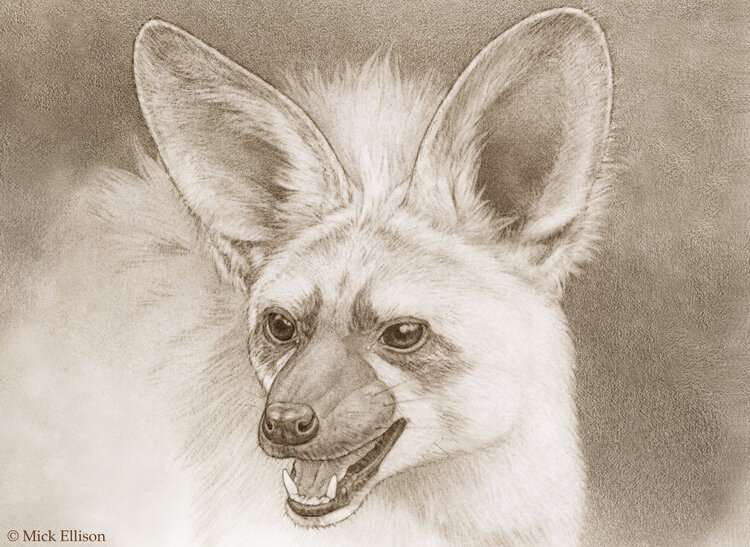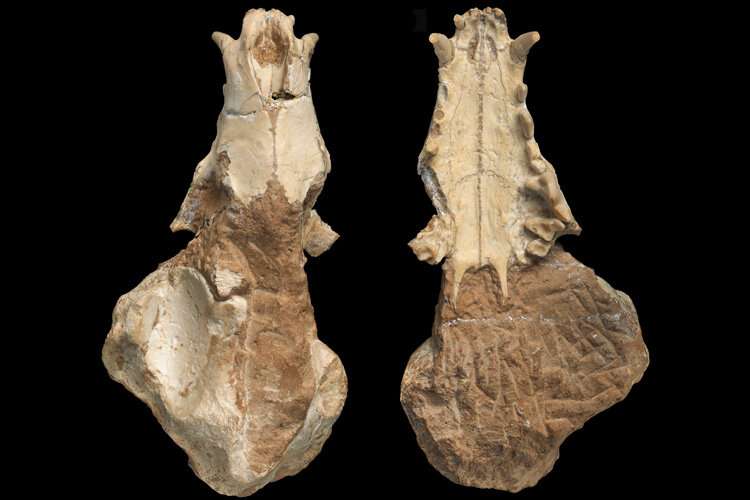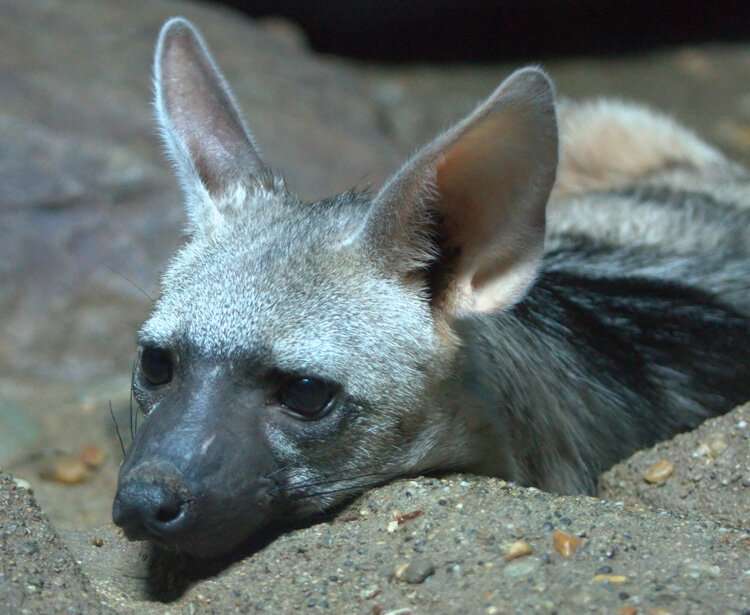Was this hyena a distant ancestor of today's termite-eating aardwolf?

Of the hundred or so known species of hyena—living and extinct—that stalked the earth, all have been meat eaters or omnivores except one, the aardwolf, which, mysteriously, eats termites.
What happened in the history of fearsome hyenas that led one group to give up raw meat and turn to insects?
Two fossil skulls of a 12- to 15-million-year-old hyena that once lived in the Gansu province of China may shed light on that mystery.
According to Jack Tseng, assistant professor of integrative biology at the University of California, Berkeley, and curator in the University of California Museum of Paleontology, the aardwolf that lives today in East and Southern Africa, Proteles cristata, is an anomaly.
"It (the aardwolf) is really quite a mysterious animal," he said. "They are hyenas, but they are really the strangest of hyenas because they don't do what other hyenas do, either living or extinct. The aardwolves are termite specialists, which couldn't be any further away from the other hyenas in terms of their ability to crunch bones or cut through meat. So, the aardwolf has always been a really curious mammal that ecologists and paleontologists alike have tried to learn more about."
A specialist on bone-cracking carnivores, Tseng has examined many fossilized hyena bones over his career, but none have had the unique characteristics of the aardwolf. Hyenas originated about 22 million years ago, and the aardwolf apparently emerged about 15 million years ago, based on an analysis of their genetic divergence from the three other living hyena species. But the only recognizable aardwolf fossils are from, at most, 4 million years ago.

Hence his interest in the new fossils from China, which fill in what until now was a long "ghost lineage"—a living species with little fossil evidence to link it to its ancestors.
The skulls—one of which is nearly complete, including the front portion of the lower jaw—were smuggled into the U.S., but fortunately acquired in 2002 by collector and paleontologist Henry Galiano. After confirming arrangements to repatriate the skulls to China, in 2013 Tseng agreed to join a small group of other paleontologists, including experts from the Institute of Vertebrate Paleontology and Paleoanthropology (IVPP) in Beijing, to analyze them.
Fossils midway between hyenas and aardwolves
Tseng, at the time a postdoctoral fellow at the American Museum of Natural History in New York, worked on the fossil skulls intermittently over the last eight years. What struck him immediately were characteristics seemingly halfway between those of bone-cracking hyenas and the aardwolf. In particular, the skulls had a broad palate, like the aardwolf, possibly to accommodate a larger, more muscular tongue with which to slurp up termites. The teeth had wider spacings, also like the aardwolf, suggesting that the Gansu hyena was moving away from a meat-carving diet.
In addition, its middle ears had spacious, dome-shaped chambers, or bullae, that are found in animals, such as some desert rodents and aardwolves, that evolved to increase hearing sensitivity—perhaps to detect the hum of a termite colony.
"Relative to skull size, the bullae are very much enlarged in the Gansu hyena, compared to modern hyenas," he said.
Similar to the extant aardwolf, the fossil also has larger eye sockets for its size than other hyenas.
While the research team is not claiming that the Gansu hyena, which it is naming Gansuyaena megalotis, was a direct ancestor of the aardwolf, it concludes that the hyena is the closest fossil yet to the living aardwolf, showing signs of having diverged from a meat-and-bone lifestyle to something closer to insectivory. The age of the fossil also fits nicely with the molecular clock estimate of the origin of the aardwolf about 15 million years ago.
"With these fossils, we can really start to get at the question, 'How does an otherwise very specialized lineage for eating meat have a member, a weird cousin, that started down this totally different path of becoming a specialized insectivore, a termite specialist?'" he said. "Now, we have the starting point and ending point, which is today. The next step is to figure out what happened in the intervening 10 million years of this lineage."

Gray market fossils
Tseng noted the difficulty of properly analyzing fossils that were excavated by farmers and came with none of the local context typically captured by paleontologists—in particular, the geologic context, which is critical to assigning an age. The Gansu hyena's age and place of origin had to be inferred from the red rock still attached to its fossilized bone.
While many paleontologists—including, in most situations, Tseng—refuse to work with such "gray market" specimens, Tseng was willing to collaborate with Galiano because they shared the same goal: repatriation of the fossils.
"I felt we needed to bring this back to its country of origin, as well as back into the scientific eye," in collaboration with Chinese scientists, he said. "My co-author, Zhan-Xiang Qiu of the Chinese Academy of Science, and I agreed to collaborate on this project with the understanding that we'll first study and publish, then physically return the specimens to China for safekeeping in their vertebrate paleontology collections."
Tseng said that Chinese fossils have a long history as "dragon bones" used in traditional medicine and that in Gansu Province, in particular, people have long dug in their crop fields to extract and sell fossils. The market switch from practitioners of Chinese medicine to fossil collectors may be encouraging more commercial excavation, which can greatly diminish the fossils' scientific value, he said.
"Paleontologists walk a fine line when working with commercial collectors to bring the fossils into a public trust, such as a research institute or museum, and in this case, some scientific journals turned down publication because the fossils were from the gray market," he said.
The group ended up publishing in the bilingual journal Vertebrata Palasiatica, which is sponsored by IVPP in Beijing. The paper is now online, but publication of the print issue has been delayed by a coronavirus outbreak in Beijing.
"There's still a lot of discussion about working with gray market or amateur-collected fossils in the paleontology community, especially among vertebrate paleontologists, because vertebrate fossils are few and far between, compared to invertebrates or plants," Tseng added. "Scientists have, at times, turned away collectors who have valuable specimens that they're willing to donate to museums because of the loss of scientific context, and the attitude that if you're collaborating with folks who are not academically trained, somehow that's not proper science."
More information: A new aardwolf-line fossil hyena from Middle and Late Miocene deposits of Linxia Basin, Gansu, China. Vertebrata Palasiatica, DOI: 10.19615/j.cnki.2096-9899.211025. www.vertpala.ac.cn/EN/10.19615 … nki.2096-9899.211025
Journal information: Vertebrata PalAsiatica
Provided by University of California - Berkeley





















